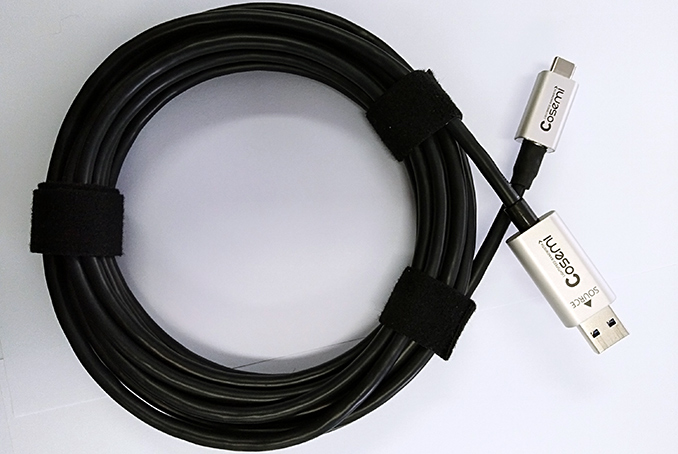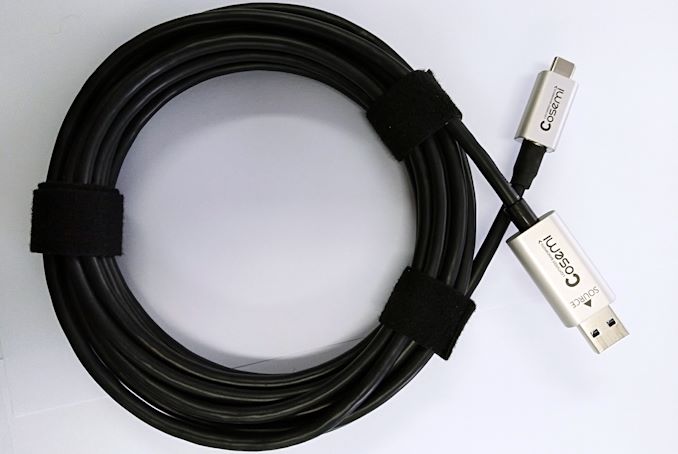Cosemi Launches USB 3.1 Gen 2 Hybrid Active Optical Cable: Up to 50 Meters of USB
by Anton Shilov on February 12, 2019 1:30 PM EST- Posted in
- Peripherals
- USB-C
- Cosemi
- USB

Cosemi has introduced the industry’s first USB 3.1 Gen 2 hybrid active optical cables (hAOC), which enable USB connectivity over distances upwards of 50 meters. The cables will be available with various connectors and therefore will be able to address various applications.
As you might guess from the name, Cosemi’s USB 3.1 Gen 2 hybrid active optical cables use fiber optics for data transfers, which is further paired with copper wires for control and power. The data portion of the cable is fully USB SuperSpeed+ capable, meaning it can transfer 10Gbps in each direction. Notable, since hAOCs can power themselves, unlike other solutions they do not need any extension boxes or repeaters, making them simpler and more reliable. Using fiber for the data channel also means that the cables are more resistant against EM and RF interference, which is particularly important for medical applications.
The manufacturer plans to offer hAOCs with various types of connectors, including USB Type-A to USB Type-A, USB Type-A to USB Type-C, as well as USB Type-C to USB Type-C, with A-to-C cables being the first type out the door. And while the cables are best geared for high bandwidth applications, like copper USB 3.1 Gen 2 cables, the hybrid active optical cables are backwards compatible with the USB 2.0 spec.
Last but not least, it's interesting to note that Cosemi’s hAOCs do not use PVC. As it turns out, this is a requirement for in-wall cables in the Americas, EMEA and Asia, as PVC produces toxic smoke when it burns.
Cosemi’s USB 3.1 Gen 2 hybrid active optical cables are sampling today, and mass production is set to start in March. The devices will be available later this year from various Cosemi’s partners, including Amazon, Liberty AV Solutions, and other. The manufacturer is not setting an MSRP quite yet, but tells us to expect them to be “competitive to USB extension box solutions.”
Related Reading:
Source: Cosemi











39 Comments
View All Comments
Diogene7 - Tuesday, February 12, 2019 - link
Would it be possible to imagine the same kind of cable but for Thunderbolt 3 ?We are in 2019, but maybe at some point we could in the future, we could imagine to have a house cabled all around with Thunderbolt 3 instead of Ethernet as it becomes more common to see ?
Sahrin - Tuesday, February 12, 2019 - link
Thunderbolt was originally intended to be a fully optical interface ("Ligh Peak" was the codename). It turned out to be much more expensive/complicated than Intel/Apple were prepared to deal with, so they came up with a nerfed version of the protocol that ran entirely on copper (today's modern thunderbolt). I haven't heard anything about what happened to the optical half of the interface (the problem with light peak as I understood it was there wasn't an economical way to include power delivery over the same cable, which was an essential feature to compete with USB).So it's possible to imagine it, but just like with how wireless has essentially eclipsed consumer copper wired ethernet, I think copper has eclipsed short-run consumer optical interfaces. It's just too cheap to use wires over fiber.
Billy Tallis - Tuesday, February 12, 2019 - link
Corning made optical TB1/TB2 cables up to 60m long, but I haven't seen any optical TB3 cables.jeremyshaw - Tuesday, February 12, 2019 - link
I remember it was Intel/Sony back then, and Sony did release one product with such an implementation (The Vaio Z "ultrabook" with an external AMD GPU dock).https://www.anandtech.com/show/4474/sony-updates-v...
jeremyshaw - Tuesday, February 12, 2019 - link
I see, Apple was still involved.marte_91 - Tuesday, February 12, 2019 - link
The only thing wireless is used for is devices without Ethernet, I will never use wireless on any device that have a wired Ethernet port available, wireless has its uses, but no it has not replaced wired, and I honestly don't see it happening, it is not as secured or fast as wired Ethernet.close - Wednesday, February 13, 2019 - link
Yeah well... we live in a world in which convenience wins over security, and very few people need that speed. So there's that.azazel1024 - Wednesday, February 13, 2019 - link
For businesses (and me personally) you are absolutely right. However, of friends and family's homes I have been in or help setup networks for I can think of 3 that have anything wired other than the router. My brother who I love, but is a little obsessed, my father who had his house wired with Cat6 when it was built a couple of years ago and one friend who I helped run some cables in to a couple of rooms because WiFi reception was so poor, so I wired up their work computer and an access point in their home office on the other side of their house.My own house has network drops EVERYWHERE. Hell, when I moved my kitchen I added a network drop behind my fridge...because who knows? Every bedroom has one. My dinning room/kitchen (one large room) have 2. One behind the fridge and 1 behind a table next to that (with AP plugged in to that drop). I have 1 in the nook that the former kitchen was in that is a future home office for my wife. I have 1 in our living room in the built in bookcases for our TV setup. The basement has 4 in the home office down there (partly because my computer setup was on the other side of the room and then I moved it, so I just added 2 more drops on the other side of it and left the existing ones). I have 2 in the main basement itself.
In fact I think the only rooms in the house that don't have network drops are the bathrooms (mudroom/laundry room has one behind the washer and dryer...because again, who knows some day). Oh, the only one in the garage is for the FIOS fiber box to run WAN access to the router in my basement. I could pretty easily run a drop or more in to the garage if I was going to wire something up.
I use wireless only for portable devices that can't be wired. Like tablets and phones. Everything else is wired.
Even a basic GbE connection is a lot faster than wireless. My wife's fairly new laptop is the fastest wireless devices we own and to my AC2600 router it can manage about 70MB/sec if the laptop is in the same room as the AC2600 or AC1750 router/AP. In the bedroom that is currently serving as my wife's home office it is about 35MB/sec down and 25MB/sec up.
That is plenty for most people, but not for me. But I am a little nuts about it. Wiring is easy to do with my house setup and then no sharing of spectrum. If I had to wait for my desktop to push/pull files over wireless, I'd actually ripe hair out. Even in the same room if I ran a 3:3 802.11ac wireless card in my desktop I'd probably hit a wall at around 90-100MB/sec.
I've got 235MB/sec on tap with dual GbE links running.
And it isn't shared.
BedfordTim - Wednesday, February 13, 2019 - link
One major problem is the fragility of fibre. It looks like a wire but the minimum bend radius is much larger. It is also much less resistant to bumps and critically pulling through ducting. We had little success with USB3 over fibre, which works in the lab but is a disaster in a factory.edzieba - Wednesday, February 13, 2019 - link
Compared to a single multicore wire, maybe. But compared to the geometrically complex multi-wire assemblies necessary for high bandwidth interconnects over longer distances (TB3, DispalyPort, HDMI, Cat6A, etc) a single optical fibre pair is FAR more flexible.